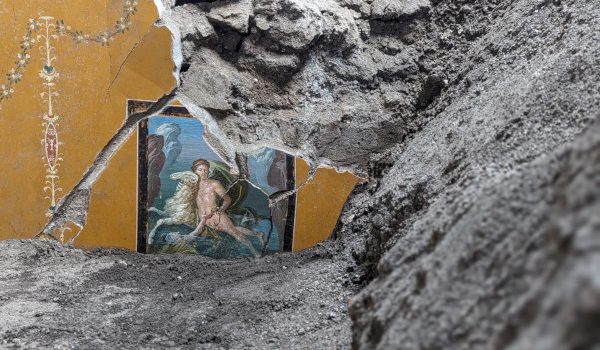POMPEII: ARCHAEOLOGICAL AND URBAN REGENERATION
Projects for over 100 million euros and the most extensive excavations since the 1950s in the context of an ancient city which has no boundaries with the surrounding territory
To mark the live YouTube broadcast for the press on the restoration work and excavations of the House of Leda, explored in 2018-2019 and now once again the subject of intervention designed to ensure accessibility and protection, Gabriel Zuchtriegel, the director of the Archaeological Park of Pompeii, focused on what he defined as a crucial moment for the UNESCO World Heritage site: in other words, a major “archaeological and urban” regeneration being carried out following the successful conclusion of the Greater Pompeii Project (Grande Progetto Pompei).
"After the years spent safeguarding the site of Pompeii as part of the Greater Pompeii Project (Grande Progetto Pompei), we are now in a phase in which we must set sail for new horizons: our work is underpinned by an approach based on town planning applied to an archaeological site, in this case an ancient city.
It is a kind of archaeological and urban regeneration that broadens our gaze from strictly archaeological and preservation-related aspects to an urban and socio-cultural vision: services for the public and for technical and safety functions, the large exhibition sites we are creating at San Paolino and Palestra Grande, the new store rooms at Porta Nola, Stabia and Torre Annunziata, shuttle services between the sites as well as accessibility, the enhancement of green areas and archaeological agriculture and sustainability, catering and the areas and workshops for children with our Children Museum.
In a nutshell, we are thinking of Pompeii as a contemporary city, with the sole difference that it has remained almost unchanged for 2000 years and consists of a global citizenship of travellers who come every day from every continent on the planet. In actual fact, we are thinking of the two cities of Pompeii, the ancient one and the modern one, but also of Scafati, Torre Annunziata, Boscoreale, Castellammare di Stabia, Terzigno, Lettere, Poggiomarino and the whole territory as a single entity from the archaeological and town planning perspective.
While the archaeological park is increasingly veering towards a town planning-based approach in terms of services and the planning of work, the municipalities of the Buffer Zone can be considered an integral part of the greater archaeological park with many archaeological sites in their territories.
Just as the ancient city was once part of a cultural landscape, it is also important today to avoid placing rigid barriers between the inside and the outside.
I have recently updated Minister Sangiuliano, whom I would like to thank for his support and willingness to listen, about the planning in the field which is part of the major archaeological and urban regeneration of ministerial sites and the territory. I would like to illustrate this with some data:
- In 2023 UNESCO approved the new Buffer Zone of Pompeii, Herculaneum and Oplontis which comprises 11 municipalities (comuni): Portici, Ercolano, Torre del Greco, Torre Annunziata, Boscoreale, Boscotrecase, Terzigno, Trecase, Pompei, Scafati and Castellammare di Stabia;
- Following the proposal of the Minister of Culture, Pompeii is included in the budget law of the Italian state for this year, which will involve “a campaign of archaeological excavations at Pompeii and in other Italian archaeological parks”;
- We currently have 28 projects related to restoration, accessibility and making the site secure, 11 others in the start-up phase, others still in the planning stage, for a planned total amount of 100 million euros;*
- Of these projects, 9 currently involve stratigraphic excavation, mainly aimed at improving the conditions of preservation and protection of the heritage that has already come to light. This means that excavations are currently being carried out in an area never reached in terms of surface area by the large-scale campaigns conducted in the 1950s: 9000 sq.m."
Besides the continuous and vital activities of monitoring, management, constant and extensive routine and planned maintenance of the archaeological sites, there are 28 projects related to restoration and making secure the site currently underway; a further 11 are in a start-up phase, for an overall amount of 53.60 million euros (for the interventions currently being carried out) and 11.00 million euros (for interventions about to start) for an overall amount of about 65 million euros allocated to 39 interventions, financed for about 50% with funds provided by Law 190, NOP Culture and Development 2014-2020 funds and the former CIPE funds.
Besides routine programming, which for the three-year period 2024-2026 involves an overall investment of about 25 million euros, the Archaeological Park of Pompeii also manages various other sources of funding used for interventions on the monumental heritage of the Park for an overall additional amount of 11.6 million euros (PNRR funds and CISS Pompei Vesuvio Napoli funds).
Overall, over 100 million euros are about to be spent on the future of the Archaeological Park of Pompeii.
LINK Bulletin House of Leda and the swan https://pompeiisites.org/bollettino-degli-scavi-di-pompei/casa-di-leda-bollettino-2024-n-01/
LINK E-Journal House of Leda and the swan
Link photos
https://we.tl/t-QsiDyj3nba
Interview with the Director
https://we.tl/t-74sehyD48I



